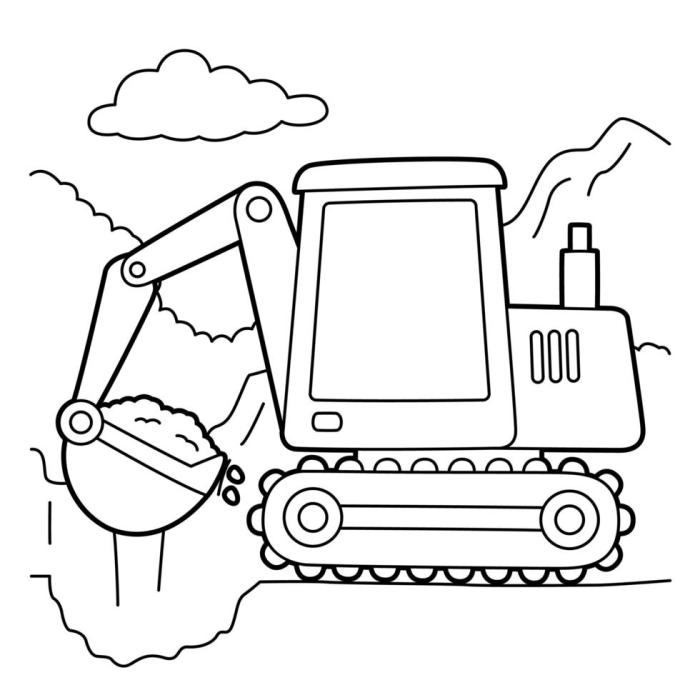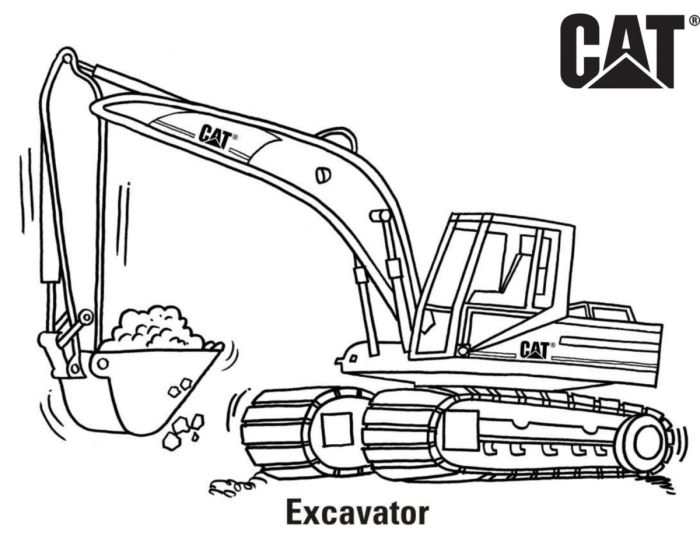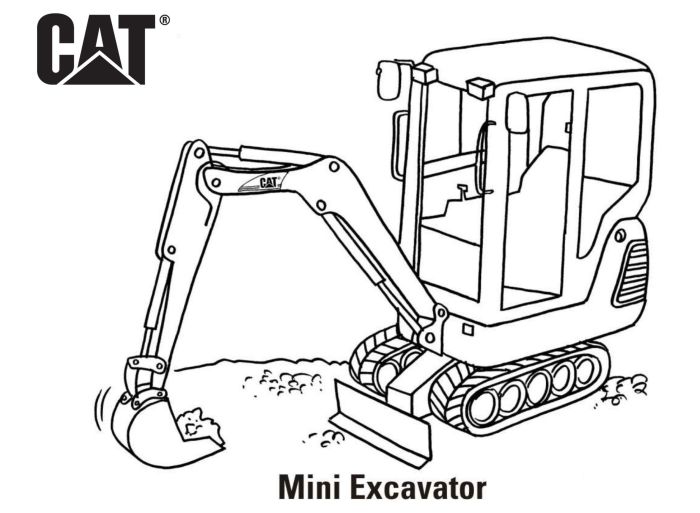Excavator Coloring Pages

Coloring pages excavator – These coloring pages offer a fun and engaging activity for children of all ages, fostering creativity and fine motor skills development while introducing them to the world of heavy machinery. The designs below cater to different skill levels, ensuring an enjoyable experience regardless of the child’s coloring abilities.
The following pages showcase a variety of excavator designs, ranging in complexity from simple Artikels suitable for younger children to more intricate illustrations that challenge older children. Each design incorporates unique features and details to stimulate imagination and provide a rewarding coloring experience.
Excavator Coloring Page Designs and Descriptions
Five unique excavator coloring page designs are presented below, each with varying levels of complexity and featuring different excavator types. The table that follows provides a summary of the design elements for each page.
Design 1: Simple Crawler Excavator
This design features a basic Artikel of a crawler excavator, with large, easily colorable sections. The body is rectangular, the tracks are simplified, and the arm is a single, straight line. Ideal for very young children.
Design 2: Detailed Wheel Excavator
This design showcases a wheel excavator with more intricate details, including a detailed cab, visible wheels, and a more complex arm and bucket. It includes small sections for more precise coloring.
Design 3: Mini Excavator with Accessories
This design depicts a smaller, compact excavator with added details such as a light bar, mirrors, and a detailed bucket. The smaller size and manageable detail make it suitable for a range of ages.
Design 4: Large Excavator with Hydraulics
This illustration features a large excavator with visible hydraulic cylinders and pipes, offering a more realistic representation. The complexity of the design requires more precise coloring and is suitable for older children.
Design 5: Excavator at a Construction Site
This design depicts an excavator working at a construction site, including additional elements such as buildings, trucks, and workers (simplified). This provides a broader context and adds a layer of complexity to the coloring experience.
| Design | Size | Detail Level | Excavator Type |
|---|---|---|---|
| Simple Crawler Excavator | Small | Low | Crawler |
| Detailed Wheel Excavator | Medium | High | Wheel |
| Mini Excavator with Accessories | Small | Medium | Mini Excavator |
| Large Excavator with Hydraulics | Large | High | Crawler |
| Excavator at a Construction Site | Large | Medium-High | Wheel |
Color Palette Suggestions
Appropriate color palettes are crucial for enhancing the coloring experience and ensuring age-appropriateness. The suggestions below consider the complexity of each design and the typical preferences of different age groups.
Design 1: Bright primary colors (red, yellow, blue) are ideal for this simple design, allowing young children to express themselves freely.
Design 2: A combination of bright and slightly muted colors can be used here. For example, a vibrant yellow for the body, dark gray for the tracks, and a darker shade of blue for the cab would create a visually appealing result.
Design 3: Consider using metallic colors for the body and accessories, combined with brighter accents. This adds a touch of realism without overwhelming the design.
Design 4: More realistic earth tones (browns, grays, greens) can be employed for this intricate design, with accents of brighter colors for the hydraulics and cab.
Design 5: A varied palette incorporating earth tones for the excavator, bright colors for the buildings, and muted colors for the workers would create a dynamic and engaging scene.
Excavator coloring pages offer a fun way for children to explore heavy machinery. If they enjoy the challenge of detailed illustrations, a shift to something sweeter might be appealing; perhaps they’d prefer the delightful designs found in coloring pages dessert , which provide a different creative outlet. Returning to the world of construction, excavator coloring pages offer a great opportunity for imaginative play and artistic expression.
Excavator Features: Coloring Pages Excavator
Excavator coloring pages offer a unique opportunity to blend creativity with education. By focusing on the machine’s key components, children can learn about mechanics and engineering in an engaging way. This section will explore how to effectively incorporate educational elements into excavator coloring pages, making learning fun and informative.
An excavator’s design is inherently educational. Its various parts work together in a complex system, offering numerous opportunities for learning about simple machines, engineering principles, and even physics. The coloring page can highlight these aspects visually, enhancing understanding through hands-on engagement.
Labeled Excavator Diagram
A detailed coloring page depicting an excavator should include labels for key components. Imagine a large illustration of an excavator, shown from a side profile. The bucket is clearly visible at the end of the arm, labeled “Bucket.” The arm itself, articulated in sections, is labeled “Arm” or further divided into “Main Boom” and “Dipper Stick.” The rotating upper structure is labeled “House,” or “Cab,” clearly showing its protective function.
The tracks, crucial for movement, are labeled “Tracks,” and the engine compartment could be labeled “Engine.” Finally, the operator’s seat within the cab could be labeled “Operator’s Cab.” A separate key provides definitions for each labeled part:
Key:
Bucket: The scoop used to dig and move material.
Arm/Main Boom/Dipper Stick: The articulated structure that moves the bucket.
House/Cab: The protective structure that houses the operator.
Tracks: The continuous treads that allow the excavator to move.
Engine: The power source of the excavator.
Operator’s Cab: Where the operator sits to control the machine.
Educational Elements Beyond Labeling, Coloring pages excavator
Incorporating educational elements beyond simple labeling can significantly enhance the learning experience. Here are three approaches:
Firstly, incorporating a simple size comparison activity can be effective. Children can be asked to color different parts of the excavator in different shades to represent the relative size and weight of each component. For example, the engine could be a darker shade of grey than the bucket to represent its heavier weight. This subtly introduces concepts of scale and relative proportions.
Secondly, a small section of the coloring page can focus on the excavator’s movements. Simple diagrams illustrating how the arm extends, retracts, and rotates can help children visualize the machine’s operational mechanics. These diagrams could include arrows to show the direction of movement, adding a kinetic element to the static image.
Thirdly, a brief fact sheet could accompany the coloring page, providing interesting information about excavators. This could include details about their uses (construction, demolition, mining), different sizes of excavators, or even the history of excavator development. This approach provides additional context and expands the learning experience beyond the visual aspect.
Target Audience & Design Considerations

Creating engaging excavator coloring pages requires careful consideration of the target audience. Different age groups possess varying levels of fine motor skills, attention spans, and artistic preferences, necessitating diverse design approaches to ensure optimal engagement and enjoyment. The following Artikels design considerations for three key age groups.
Successful coloring page design hinges on understanding the developmental stages and capabilities of the intended users. Younger children require simpler designs to build confidence and master basic coloring techniques, while older children benefit from more complex illustrations that challenge their skills and creativity.
Design Considerations by Age Group
The following points detail the specific design elements appropriate for each age group, highlighting the differences in complexity, detail, and aesthetic appeal.
- Preschool (Ages 2-5): Designs should feature large, simple shapes with bold Artikels. Minimal detail is key, focusing on easily recognizable elements of an excavator, such as a large bucket and cab. The color palette should be bright and vibrant, using primary colors for maximum visual appeal. Consider using chunky lines and fewer intricate details to accommodate smaller hands and limited fine motor skills.
An example would be a coloring page depicting a single, large excavator bucket with only a few simple lines to define the shape.
- Elementary School (Ages 6-12): For this age group, designs can incorporate more detail and complexity. The excavator could be depicted in a more realistic style, including additional features like tracks, wheels, and a rotating arm. Lines can be thinner and more refined, allowing for more intricate coloring. The color palette can be expanded to include secondary and tertiary colors, encouraging experimentation with shading and color mixing.
An example could be a coloring page showing an excavator digging a hole, with details such as a driver in the cab and rocks surrounding the excavation site.
- Older Children (Ages 13+): Designs for older children can be highly detailed and realistic, showcasing the intricacies of an excavator’s mechanical components. These pages can include smaller, more complex shapes and lines, requiring greater precision and dexterity. Shading and highlighting techniques can be employed to create a three-dimensional effect. A more sophisticated color palette, including nuanced shades and tones, can be used to enhance the realism of the illustration.
An example could be a detailed illustration of a specific excavator model, with all its parts accurately depicted, ready for advanced coloring and shading techniques.
Creative Applications & Extensions

Extending the simple act of coloring excavator pages can unlock a wealth of creative opportunities for children, fostering imagination and developing crucial skills. These activities can transform a passive coloring experience into an engaging, multi-faceted learning process. Moving beyond the page allows children to solidify their understanding of excavators and engage with the subject matter in more dynamic ways.The coloring pages can serve as the springboard for several creative extensions, each offering unique benefits.
These extensions are designed to build upon the initial engagement with the excavator imagery, encouraging children to think critically and creatively. They provide opportunities to develop narrative skills, spatial reasoning, and fine motor control.
Storytelling with Excavators
Children can create their own stories featuring the excavator they have colored. This could involve the excavator participating in a construction project, rescuing animals, or even going on an adventure. The act of storytelling encourages imaginative thinking, language development, and narrative structure. Children can draw further illustrations to accompany their story, further enhancing their creative expression. A simple story might involve the excavator digging a hole for a new tree, encountering a family of rabbits in the process, and then helping them relocate to a safer area.
This allows children to explore themes of responsibility, problem-solving, and environmental awareness within their narrative.
Building an Excavator Model
Constructing a three-dimensional model of an excavator using readily available materials like cardboard boxes, straws, and construction paper provides a tactile and spatial learning experience. This activity enhances fine motor skills, problem-solving abilities, and an understanding of three-dimensional shapes and spatial relationships. Children can use the colored excavator page as inspiration for their model’s design and color scheme. They might choose to recreate specific details from the coloring page, or they could let their imagination run wild and create a unique version of the machine.
The process of building the model requires planning, design choices, and problem-solving as children encounter challenges and find creative solutions.
Creating an Excavator-Themed Craft
Children can create a variety of crafts based on their colored excavator page. This could involve making an excavator-themed mobile, a pop-up card featuring the excavator in action, or even a small diorama showcasing the excavator at a construction site. These activities foster creativity, enhance fine motor skills, and allow for self-expression. For example, creating a pop-up card requires careful planning and execution, involving the folding and layering of paper to create a three-dimensional effect.
This enhances their understanding of spatial relationships and develops their fine motor skills.
Step-by-Step Guide: Building a Cardboard Excavator Model
This activity utilizes readily available materials and simple construction techniques. It is designed to be accessible to children of varying ages and skill levels.
- Gather materials: Cardboard box (for the body), straws (for the arm and bucket), construction paper (for details), glue, scissors, markers or crayons.
- Cut the cardboard box: Cut the box to create the main body of the excavator. Consider the shape and size, referencing the colored excavator page for inspiration.
- Construct the arm and bucket: Use straws and construction paper to create the excavator’s arm and bucket. Securely attach them to the main body using glue.
- Add details: Use construction paper, markers, or crayons to add details such as wheels, windows, and lights. Reference the coloring page for accurate details.
- Decorate: Decorate the excavator with colors and designs, potentially mirroring the coloring page or creating a unique design.
These creative extensions, while seemingly simple, offer significant developmental benefits. They encourage children to think outside the box, develop problem-solving skills, and enhance their creativity. The process of translating a two-dimensional image into a three-dimensional model or a narrative story encourages critical thinking and spatial reasoning. The ability to adapt and overcome challenges during the construction process builds resilience and problem-solving skills.
The act of storytelling fosters language development, imaginative thinking, and narrative construction. These activities are not just fun, they are valuable learning experiences.
Illustrations & Visual Descriptions
Visual representations are crucial for engaging children and conveying the essence of excavators. Effective illustrations should capture the machine’s power and functionality while maintaining an age-appropriate aesthetic. Detailed descriptions allow for a comprehensive understanding of the visual elements involved in creating compelling coloring pages.
Realistic Excavator Illustration
Imagine a large, yellow excavator on a bustling construction site. The sun, positioned high in the sky, casts strong shadows, highlighting the machine’s powerful form. The excavator’s metallic body gleams, reflecting the sunlight with a slightly oily sheen, suggesting recent use. The texture of the metal is rough, with visible rivets and scratches, indicating wear and tear from its hard work.
The cab is a deep, dark gray, offering a stark contrast to the bright yellow of the body. The treads are deeply etched with grooves, showing the soil clinging to their edges, indicating the excavator’s recent activity. The background is a muted palette of browns and grays, with various construction elements such as half-built buildings, piles of dirt, and other heavy machinery subtly present.
The overall scene is vibrant yet grounded in realistic detail, showcasing the excavator in its natural working environment. A soft atmospheric perspective is employed, making distant elements less sharp and slightly bluish, further enhancing the sense of depth. The shading uses a combination of chiaroscuro (strong contrasts between light and shadow) to define the excavator’s form and subtle gradients to create a sense of volume and texture.
Cartoon Excavator Coloring Page Illustration
The coloring page features a friendly cartoon excavator with large, expressive eyes. Its body is a bright, cheerful yellow, with exaggerated features to appeal to children. The bucket is oversized and slightly rounded, resembling a playful scoop. The tracks are simplified, with bold lines and minimal detail, making them easy for children to color. The excavator has a cheerful smile and rosy cheeks, giving it a happy and approachable demeanor.
Small, simple details, such as a small, friendly-looking driver peeking out of the cab, are included to add personality. The background of the coloring page is left mostly blank to allow for creative expression, with only a few simple elements, like some sparsely drawn clouds or a simple sun, included. The line art is bold and simple, allowing for easy coloring and minimal frustration for young children.
The overall aesthetic is bright, playful, and designed for easy color application.
Artistic Styles in Excavator Coloring Pages
Different artistic styles can be incorporated to create diverse and engaging coloring page designs. A realistic style, as described above, can offer a detailed and accurate representation of an excavator, appealing to older children or those interested in engineering. A cartoonish style, characterized by exaggerated features and simplified forms, is ideal for younger children, emphasizing fun and playful imagery.
An abstract style might represent the excavator through geometric shapes and bold color blocks, focusing on the machine’s essence and form rather than its realistic appearance, providing a more modern and experimental design. These varying approaches cater to different age groups and artistic preferences, ensuring a wider appeal.
